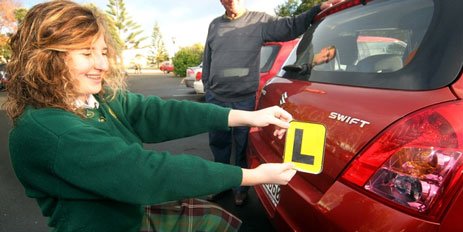Two-thirds of drivers pass their test - May 2015

HAPPY: Jack Kennedy pictured with a successful WHS student Shea-Lee Phillips back in 2012.
The success rate for the restricted driving test in Wanganui is the highest it has been in four years.
Information released by the New Zealand Transport Agency shows 66 per cent of people in the region who sat restricted licence tests in March passed. That rate is much higher than the national rate of 58 per cent.
Pass rate numbers have bucked national trends, staying consistently high since March 2012, despite changes which were made to the restricted driving test.
On February 27, 2012, the restricted driving test was made harder and longer as part of an initiative by the NZTA to make roads safer. The age limit for getting a learner licence was also raised from 15 to 16.
Unlike many regions whose pass rates dropped considerably after the changes, Wanganui maintained a pass rate of about 50 per cent.
DriveSafe Driving School driving instructor Jack Kennedy said more people were getting professional training, which had led to an increase in the pass rate.
"The candidates are coming to the test more prepared than they used to be and they are better drivers now," he said.
"They realise that the test is harder and it is going to cost them a lot more to go through an instructor if they haven't done the homework."
Mr Kennedy said learner drivers in Wanganui quickly realised they would need to improve their driving to pass the restricted driving test.
"At the very, very start, the pass rate wasn't flash and word got around fast that people would need to do more work to pass," he said.
"For a while the phone here was very quiet, then all of a sudden it was quite busy."
According to the NZTA data, learner drivers across the country who sat their restricted test passed at a rate of 58 per cent in March this year. This was a substantial increase from the pass rate of 38 per cent in March 2012.
AA Driving School general manager Nigel Clark said changes to the restricted licence test had produced a positive outcome: "Firstly the age was changed, so it was 15 and now it is 16. This is good because young people definitely develop better skills as they get older.
"And the test being harder means more people are taking professional instruction because they won't pass unless they do.
"That means you have people being taught in a better way. We are teaching three times more people per week than we were doing in 2012.
"More people are being exposed to professional tuition which over time should improve the pass rate and help people be safer drivers," Mr Clark said.
The figures were, in fact, unfair to younger people because the pass rates for people from 16 to 20 were substantially higher than their older counterparts, he said.
The pass rate for 55-59 year olds was 32 per cent while the pass rate for 18 year-olds was 57 per cent and it was 60 per cent for 19 year-olds in March this year.
